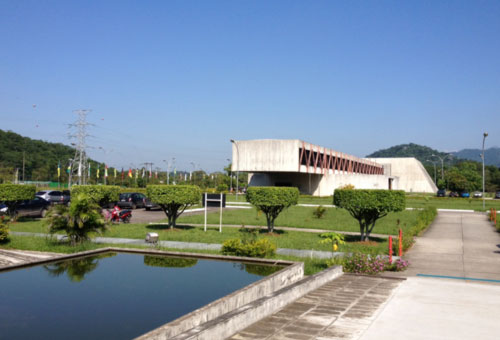
Long and low – Inmetro, Brazil’s standards lab.
By Michael Banks in Rio de Janeiro, Brazil
As part of my road-trip round Brazil, I visited Inmetro – the Brazilian standards lab. Located around 50 km north of Rio de Janeiro, Inmetro certainly has the feeling of being well away from the hustle and bustle of one of Brazil’s major cities.
The first thing that you notice when you enter Inmetro’s vast campus is that the buildings have a unique architecture (see above). The bunker-like structures are built in such a way that they are protected from the Sun, which can deliver 40 °C temperatures in summer. (Thankfully, I am here in autumn, but the temperature is still a warm 30 °C.)
Inmetro’s campus was built about 40 years ago with the help of the PTB – the German standards lab. The buildings were also specially designed so that the labs are vibrationally separate from the offices. So, any wild jumping around at your desk won’t affect the sensitive measurements in the lab.
Inmetro has traditionally carried out all kinds of metrology, covering chemical, mechanical and optical standards. But in 2000 bosses at the lab decided to focus more on research rather than just doing precise measurements, so they bought new instruments and hired scientists and students to start up research groups.

High-spec – Inmetro offers a range of top-class equipment.
The materials section at Inmetro was one of those departments born in 2000. The government ploughed money into the centre, allowing researchers to buy a host of equipment for materials science, including scanning electron microscopes, X-ray diffractometers and tunnelling electron microscopes. The researchers now use these to study a range of materials from nanoparticles and graphene to ball joints that are used in hip replacements.
“Inmetro has to do everything and in the best possible way,” says Marco Cremona from the centre, who is also based at PUC-Rio. “It is a unique institution in Brazil where you can find all of this equipment under one roof.”
Yet all these microscopes and spectrometers are not just for Inmetro researchers. The centre runs a proposals programme where it offers time on its machines to external users. Researchers at other institutions write proposals and then either send their samples to Inmetro or go there themselves to carry out the measurements.
But the real benefit of the programme is that the central government does not have to put the best microscopes in every laboratory but can locate them centrally at Inmetro. Not only that, it also fosters collaboration by allowing people from different labs to work together.
You can read more about research in the country in the latest Physics World Special Report: Brazil.
Guidelines
Show/hide formatting guidelines
this text was deletedwhere people live in harmony with nature and animals</q>
Some text